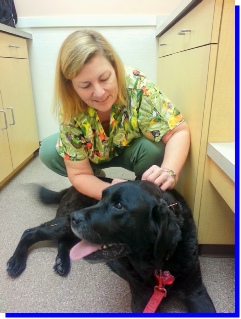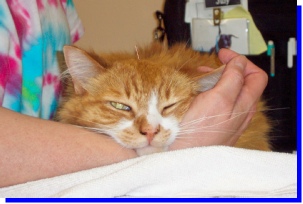Integrative medicine is the most powerful approach available for optimizing quality of life and lifespan in veterinary patients. Our pets are susceptible to a number of conditions that are ideally treated with integrative therapy, including arthritis, kidney disease, inflammatory bowel disease, cancer, disk problems (pain, weakness and paralysis), incontinence, and chronic skin and ear problems, among others. Conventional therapy for most of these diseases is unfortunately very limited, but combining this with holistic treatment can significantly improve well-being and potentially extend life for months or years.
Integrative Medicine (IM) combines the most appropriate treatments from conventional veterinary medicine and surgery with methods such as acupuncture (AP) and herbal medicine, which are derived from much older, holistic disciplines. Integrating therapies from different medical systems provides a much broader array of therapeutic options. Treatment is tailored to fit the specific circumstances of each individual, and to capitalize on the enhanced effects produced when treatment methods are combined. In addition, holistic treatment with acupuncture and/or herbal medicine can often be used to decrease or even eliminate the need for conventional drugs, which can sometimes have undesirable side effects. IM literally gives the patient “the best of both worlds,” by taking advantage of the safest and most effective treatments available. This will ensure that our precious pets can stay with us for as long as possible.
In addition to conventional medical training, an integrative veterinarian will also have specialized training in one of the holistic medical disciplines, such as Traditional Chinese Veterinary Medicine (TCVM), Ayurvedic Medicine, or Japanese Kampo and Acupuncture. In contrast to conventional western medicine, a holistic (a.k.a. “wholistic”) system treats the whole body all at once rather than just an isolated area or part of the body. Therefore, diagnosis and treatment acknowledges that the body is a dynamic, interactive system rather than merely a collection of unaffiliated parts.
Two examples illustrate how integrative medicine employing a combination of conventional medicine and Traditional Chinese Veterinary Medicine (AP, Herbal) is used to treat diseases that affect dogs and cats. The first example shows how treatment of hip pain due to arthritis works using this holistic and integrative approach. An integrative doctor will combine conventional diagnostics, including joint manipulation and possibly x-rays, with a holistic exam from nose to tail, and a review of the pet's history, diet, and behavior. Therapy might include pharmaceutical pain medicine (at least initially) to provide immediate pain relief, together with acupuncture treatments, which are cumulative and take time to reach full effectiveness. The AP will treat not only the arthritic hips, but will also include other areas of the body that interact with, and are affected by the hips. These other areas include the knees, spine, neck and shoulders. This approach explicitly recognizes that it is not possible to optimize hip health and function without treating the other areas of the body related to the hips.
But how and why are other areas of the body related to arthritic hips? To begin with, pets with arthritic hips will chronically adjust how they stand, walk, and sit, in order to compensate for and minimize the hip pain. These adjustments in turn throw off the movement and biomechanics of the rest of the body, which then affects otherwise healthy joints. For example, hip muscles get smaller and weaker from disuse. Knees come under greater stress as they are forced to adjust to an altered gait. In addition, the neck, shoulders, and front legs must all carry a heavier percentage of the animal's weight. Because of these ongoing compensatory effects, pain in the hip joints can profoundly increase wear and tear on other joints, and produce pain in the rest of the body.
Treating arthritic hip pain in isolation without recalibrating the entire system will merely perpetuate arthritic progression, leave compensatory wear and tear untreated, and even decrease the overall effectiveness of the therapy targeted specifically at the hips. This holistic approach helps the entire body function more efficiently, and is the primary reason that people routinely report that their pets are feeling and acting “younger” because of the initial course of AP therapy. It also ensures that arthritic cats and dogs are receiving the absolute minimum amount of pharmaceuticals necessary for pain control, in the event that any are still required after the acupuncture has taken effect. While conventional pain drugs are usually very safe and effective, a lower dose decreases the chances of side effects from these medicines.
The second example of the use of IM is in the treatment of cancer. An integrative approach can be extremely beneficial and help extend the lives of many afflicted pets. While neither conventional nor holistic methods are able to cure this disease (unless the tumor can be completely excised), we are continuing to discover powerful combinations of conventional and holistic therapies and to formulate new and improved treatment protocols.
Holistic medicine is safe to use right alongside conventional treatments such as chemotherapy, and is ideally initiated as soon as possible after the dog or cat is diagnosed. Because chemotherapy can sometimes have undesirable side effects, people may choose to use only holistic treatment, or choose conventional options that are less likely to have complications, and include these along with holistic. For example, many people want their pets to undergo conventional surgery to remove the primary tumor, but don't want them to have any follow-up chemotherapy. The treatment protocol for integrative patients is completely flexible, and specific approaches are selected and combined based on the particular needs of each pet and each family.
Conventional cancer treatment with surgery, radiation, or chemotherapy can potentially decrease tumor size by excision (surgical removal) or by rapidly killing a number of cancer cells. At the same time, herbal medicine is given to change the prevailing physiologic conditions in the body that originally allowed the tumor to grow and flourish. This makes the body's internal environment less “hospitable” to the remaining tumor cells, and works to suppress or retard their growth and spread (i.e., similar to conventional “metronomic” therapy, which helps to suppress formation of new blood vessels to supply the growing tumor). In addition, some herbal medicines (e.g. milk thistle) will actually enhance the effectiveness of specific chemotherapy agents, while simultaneously helping to protect against their toxic side effects on the liver. A few herbals, such as Pacific yew bark and rosy periwinkle, have themselves been developed into chemotherapy drugs, and are used in human cancer patients (Taxol; vincristine/vinblastine).
Acupuncture can be used supportively in cats and dogs with cancer to stimulate appetite, normalize digestion, decrease pain, and preserve mobility. It can also help their bodies to function at their full potential, so they are theoretically in the best possible shape to resist tumor spread. Many human patients report that acupuncture treatment decreases fatigue, increases energy levels, and makes them feel better, overall. In addition, it is used in both humans and pets to help decrease side effects such as vomiting or diarrhea that can be caused by conventional chemotherapy. There are currently over 150 on-going clinical trials sponsored by the National Institutes of Health, that are investigating the effectiveness of AP for various conditions in human cancer patients, as well as for a number of other diseases.
Though all medical systems have limits, if your pet is receiving the appropriate holistic medicine in addition to the optimum conventional protocol, you can rest assured that he or she is getting the absolute best available treatment. This integrative approach essentially leaves no stone unturned, and then utilizes the specific therapies that will be most effective and offer the best possible life.


